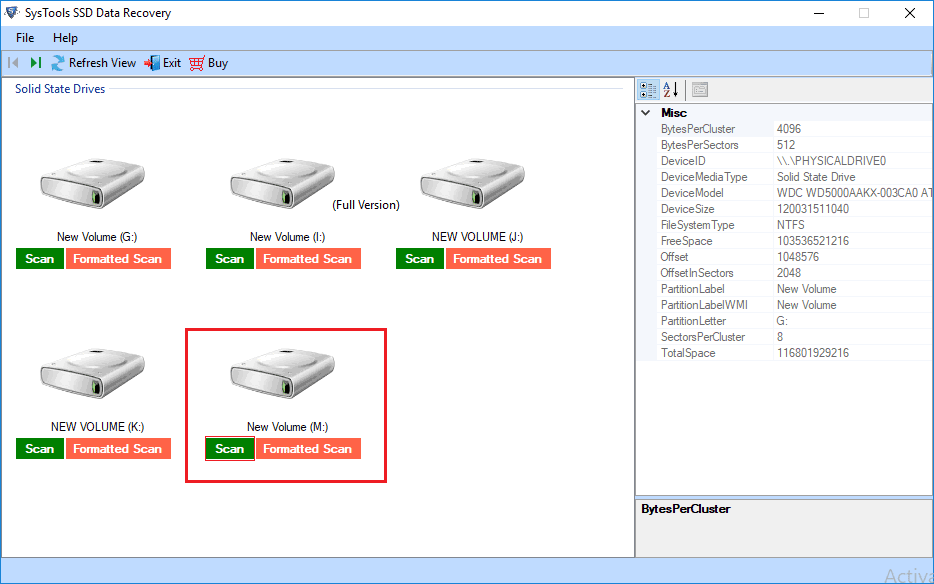

- #Ssd format utility intel install
- #Ssd format utility intel update
- #Ssd format utility intel series
- #Ssd format utility intel download
- #Ssd format utility intel windows
Nvme nvme0: Device not ready aborting reset, CSTS=0x1 Nvme nvme0: I/O 24 QID 0 timeout, reset controller Nvme nvme0: I/O 840 QID 6 timeout, reset controller Nvme nvme0: I/O 990 QID 1 timeout, aborting Nvme nvme0: I/O 989 QID 1 timeout, aborting Nvme nvme0: I/O 566 QID 7 timeout, aborting This is a known issue for Kingston A2000 as of firmware S5Z42105 and has previously been reported on Samsung NVMe drives (Linux v4.10) Ī failure renders the device unusable until system reset, with kernel logs similar to: Some NVMe devices may exhibit issues related to power saving (APST). Troubleshooting Controller failure due to broken APST support This should enable APST and make the table in nvme get-feature (as the root user) show the entries. If the total latency of any state (enlat + xlat) is greater than 25000 (25ms) you must pass a value at least that high as parameter default_ps_max_latency_us for the nvme_core kernel module. The output of nvme id-ctrl /dev/nvme (as the root user) should show the available non-operational power states of the NVME controller. If APST is enabled but no non-zero states appear in the table, the latencies might be too high for any states to be enabled by default. When APST is enabled the output should contain "Autonomous Power State Transition Enable (APSTE): Enabled" and there should be non-zero entries in the table below indicating the idle time before transitioning into each of the available states. # nvme get-feature /dev/nvme0 -f 0x0c -H get-feature:0xc (Autonomous Power State Transition), Current value:0x000001Īutonomous Power State Transition Enable (APSTE): Enabled
#Ssd format utility intel install
To check NVMe power states, install nvme-cli or nvme-cli-git AUR, and run nvme get-feature /dev/nvme -f 0x0c -H: Raw device performance tests can be run with hdparm: NVMe SSDs are known to be affected by high operating temperatures and will throttle performance over certain thresholds. Intel, as one device manufacturer, recommends not to enable discards at the file system level, but suggests the periodic TRIM method, or apply fstrim manually. Warning: Although continuous TRIM is an option (albeit not recommended) for SSDs, NVMe devices should not be issued discards.ĭiscards are disabled by default on typical setups that use ext4 and LVM, but other file systems might need discards to be disabled explicitly. See Advanced Format#Setting native sector size. Then proceed with the generic flashing instructions. Firmware files appear to use a predictable naming scheme based on the firmware revision:
#Ssd format utility intel windows
Kingston does not provide separate firmware downloads on their website, instead referring users to a Windows only utility.
#Ssd format utility intel update
# intelmas load -intelssd 0 WARNING! You have selected to update the drives firmware! If so, execute the load command as follows:
#Ssd format utility intel series
# intelmas show -intelssd - Intel SSD 660p Series redacted. Install intel-mas-cli-tool AUR and check whether your drive has an update available: Use this tool to manage PCIe*-/NVMe*- and SATA-based Client and Datacenter Intel® SSD devices and update to the latest firmware." "The Intel® Memory and Storage Tool (Intel® MAS) is a drive management tool for Intel® SSDs and Intel® Optane™ Memory devices, supported on Windows*, Linux*, and ESXi*. # echo 1 > /sys/class/nvme/nvme0/reset_controller # nvme fw-commit -s 2 -a 2 /dev/nvme0 Success committing firmware action:2 slot:2įinally reset the controller to load the new firmware # nvme fw-commit -s 2 -a 0 /dev/nvme0 Success committing firmware action:0 slot:2
#Ssd format utility intel download
# nvme fw-download -f S5Z42_fw_S5Z42105.bin /dev/nvme0 Firmware download success Refer to the NVMe specification for details on firmware commit action values. Next, an existing image is activated ( -a 2). In the example below, firmware is first committed without activation ( -a 0). # nvme id-ctrl /dev/nvme0 -H | grep Firmware : 0ğirmware Slot 1 Read/Writeĭownload and commit firmware to specified slot. # nvme fw-log /dev/nvme0 Firmware Log for device:nvme0 To display available slots and check whether Slot 1 is read only: See Solid state drive/Memory cell clearing#NVMe drive.įirmware can be managed using nvme-cli.
and the official wiki entry for more information, and see this article for contextual information about the output. The smartd daemon tracks health ( -H), error count ( -l error) and temperature ( -W DIFF,INFO,CRIT).Ability to fetch any nvme log ( smartctl -l nvmelog,N,SIZE).SMART overall-health self-assessment test result and warnings ( smartctl -H).Controller and namespace capabilities ( smartctl -c).Basic information about controller name, firmware, capacity ( smartctl -i).Note: smartmontools official wiki reports this support as experimental.Ĭurrently implemented features (as taken from the wiki):


 0 kommentar(er)
0 kommentar(er)
